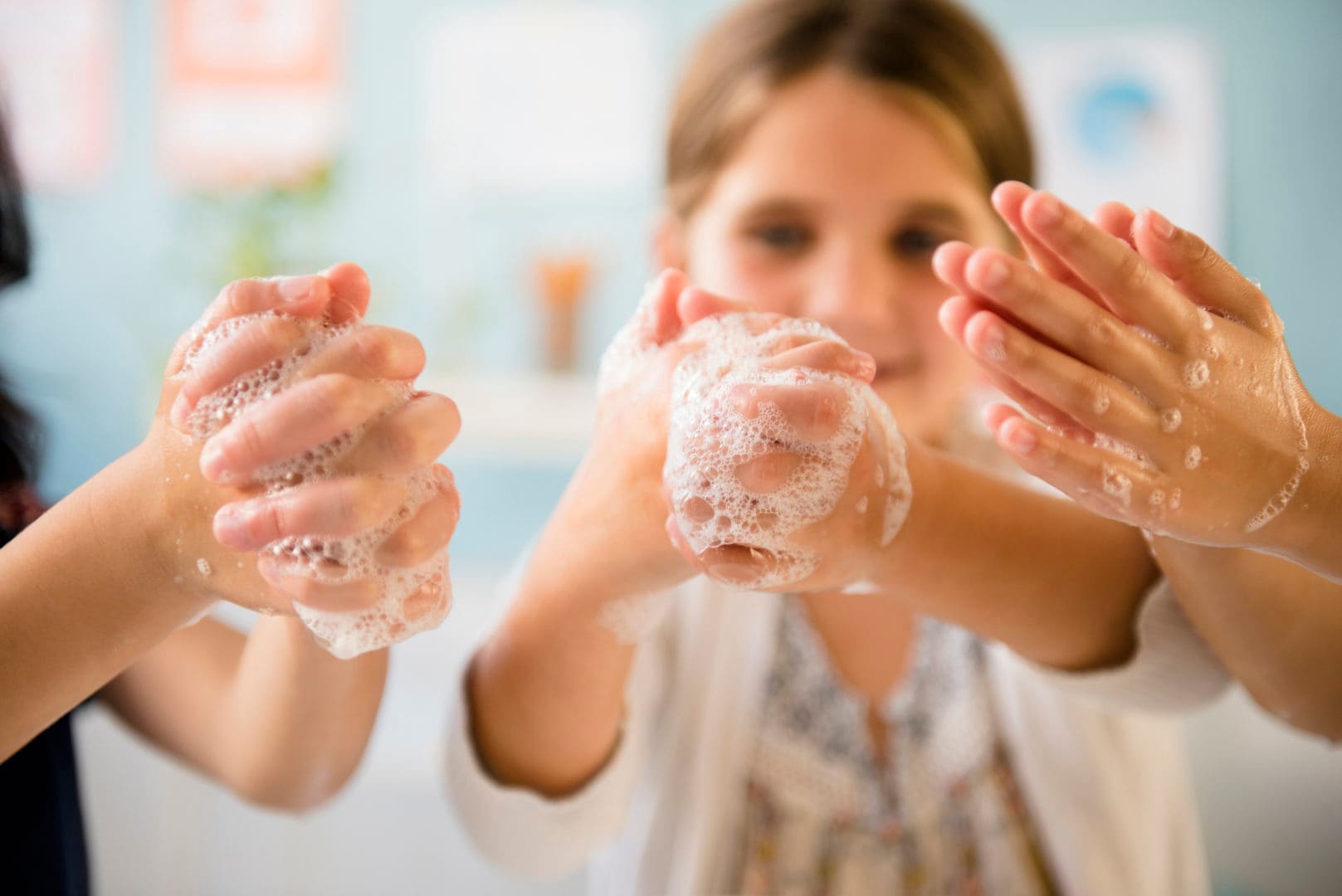We’re currently facing a novel coronavirus pandemic that’s continuing to rapidly spread across the U.S. and the world. As of Monday, September 21, the World Health Organization (WHO) clocked the total number of cases in the U.S. at 6,703,698, including 198,094 deaths. Confirmed cases worldwide have reached over 30 million.
The Centers for Disease Control and Prevention (CDC) advised that the virus is still spreading from person-to-person in many affected geographic areas.
If you are a parent or caregiver and suspect you may be sick, please note the following advice:
-
Parents: If you, your child or anyone in your household are sick, do not schedule child care and do cancel any child care (with pay if possible) that you have previously scheduled.
-
Nannies, babysitters, caregivers: Stay home and do not care for children.
Here, experts weigh in on the most frequently asked COVID-19 questions and what you can do to best protect yourself and your loved ones.
Read more: Coronavirus resource guide for parents and caregivers
What is coronavirus and COVID-19?
According to the CDC, coronaviruses are a large family of viruses common to many species of animals, such as camels, cattle, cats and bats. In rare cases, these viruses can jump to and spread among humans, such as with MERS and SARS. The current coronavirus — also referred to as a novel (new) coronavirus, or SARS-CoV-2 — was first detected in 2019, in Wuhan City in the Hubei Province of China. It has since been detected in travelers, as well as confirmed in people without known exposure to the region or other known patients.
The name of the illness caused by SARS-CoV-2 is called COVID-19, short for “coronavirus disease 2019.”
“Since this virus is in the family of viruses that cause the common cold, it’s likely that healthy children and adults will resolve the illness on their own and recover without any problems,” notes Rodney Rohde, chair and professor of the Clinical Laboratory Science (CLS) Program and associate dean for Research for the College of Health Professions at Texas State University.
How is coronavirus transmitted?
“The virus is thought to spread mainly from person-to-person — between people who are in close contact with one another (within about six feet), through respiratory droplets produced when an infected person coughs or sneezes,” says Amy Fuller, a registered nurse who holds her doctorate in nursing practice and is director of Endicott College’s family nurse practitioner master’s degree program. “These droplets can land in the mouths or noses of people who are nearby or possibly be inhaled into the lungs.”
Researchers are still examining how the virus might, in certain environments, spread through aerosols, or small particles that can linger longer in the air than larger droplets. That said, as of September 18, the CDC reports that they are currently updating its recommendations regarding airborne transmission.
And while it may be possible that a person can get COVID-19 by touching a surface or object that has the virus on it and then touching their own mouth, nose or possibly their eyes, this isn’t thought to be the main way the virus spreads, notes the CDC.
In short, it’s transmitted via the respiratory route like a cold or flu, notes Rohde.
If you’re pregnant or breastfeeding: The CDC states that it’s still unknown whether a pregnant woman with COVID-19 can transmit coronavirus to her fetus or newborn. Some babies have tested positive for the virus shortly after birth, but it’s unclear if the babies got the virus before, during or after birth. One systematic review, published in BJOG: An International Journal of Obstetrics and Gynaecology, has concluded that transmission is uncommon. And another small study of nine pregnant women who were infected with COVID-19 found that the virus was not present in amniotic fluid, the babies’ throats or in breast milk.
What are the symptoms?
The CDC notes that COVID-19 can present with a variety of symptoms, including:
-
Fever or chills
-
Cough
-
Shortness of breath or difficulty breathing
-
Fatigue
-
Muscle or body aches
-
Headache
-
New loss of taste or smell
-
Sore throat
-
Congestion or runny nose
-
Nausea or vomiting
-
Diarrhea
Some people with COVID-19 are also experiencing cardiovascular symptoms, neurological symptoms and/or gastrointestinal (GI) symptoms. These may occur with or without respiratory symptoms.
Symptoms may present anywhere from 2-14 days following exposure, according to the CDC.
What are the symptoms in kids specifically?
Children who have COVID-19 might experience fever, cough, nasal congestion or a runny nose, sore throat, shortness of breath, diarrhea, nausea or vomiting, fatigue, headache, muscle aches, poor feeding or poor appetite, notes the CDC. That said, children with COVID-19 may not initially present with fever and cough as often as adult patients.
While severe illness has been reported in children, most often in infants less than a year, the American Academy of Pediatrics (AAP) reassures parents that severe illness among kids is uncommon. A large European study, published on June 25, in the journal Lancet Child & Adolescent Health, found that COVID-19 is fatal for well fewer than 1% of children, and the vast majority will not need intensive care.
It also bears noting that some children have been diagnosed with a serious health condition called Multi-System Inflammatory Syndrome in Children (MIS-C), which is associated with SARS-CoV-2 and presents with signs of inflammation in many or all of their internal organs, such as the intestines, heart, lungs and kidneys. The AAP reminds parents that this condition is still very rare.
Who is most at risk?
Older adults and people with underlying medical conditions: This group remains at increased risk for severe illness, but the CDC has further defined age- and condition-related risks.
Consistent evidence shows that specific medical conditions increase a person’s risk of severe COVID-19 illness:
-
Chronic kidney disease.
-
COPD (chronic obstructive pulmonary disease).
-
Obesity (BMI of 30 or higher).
-
Immunocompromised state (weakened immune system) from solid organ transplant.
-
Serious heart conditions, such as heart failure, coronary artery disease, or cardiomyopathies.
-
Sickle cell disease.
-
Type 2 diabetes.
The CDC stated previously that people who live in a nursing home or long-term care facility are also at higher-risk.
Pregnant people: Pregnant people might be at an increased risk for severe illness from COVID-19 compared to non-pregnant people, according to the CDC. There might also be an increased risk of adverse pregnancy outcomes, such as preterm birth, among pregnant people with COVID-19.
Additionally, research published on June 25 found that pregnant women with COVID-19 were significantly more likely to be hospitalized, be admitted to the ICU and receive mechanical ventilation than nonpregnant women. However, pregnant women were not at greater risk for death from COVID-19, according to the findings.
Certain racial and ethnic groups: Although CDC officials are still determining recommendations for racial and ethnic minority groups, data shows COVID-19 hospitalization rates are 4 times higher for Hispanics, 4.5 times higher for Black people and 5.5 higher for American Indians and Alaska Natives when compared with white Americans.
A note on children and risk: The CDC says that while infections in children, including very young children, have been reported, there is no evidence that they are more susceptible. The most recent data from the American Academy of Pediatrics and the Children’s Hospital Association notes that children represented 10% of all cases in states reporting cases by age, and over 549,000 children have tested positive for COVID-19 since the onset of the pandemic.
What precautions should I take?
The combination of wearing a cloth face covering while following every day preventive actions and practicing physical distancing in public settings can preempt illness and slow the spread of COVID-19, notes the CDC.
One of those preventative actions is hand-washing, which Rohde says “is always an effective tool to prevent coming into contact with any microbial agent. Be an example to your children, teaching them how to wash their hands, as well.”
Although alcohol-based hand sanitizers are flying off the shelves, and the CDC advises using them when soap and water aren’t readily available, it’s best to wash your hands often with soap and water for at least 20 seconds, especially after going to the bathroom, before eating and after blowing your nose, coughing or sneezing.
At the same time, Rohde urges avoiding “high-touch” surfaces — other people (handshaking), handrails, etc. — when possible, as well as contact with those who are ill (or appear ill) with respiratory illness, travel to high infection areas abroad or domestic and visits to nursing homes or other health care areas where high risk may be found unless you need to obtain assistance.
The CDC also recommends:
-
Avoiding close contact (defined as within six feet or having direct contact like kissing or sharing utensils) with people who are sick.
-
Putting physical distance between yourself and other people outside of your home.
-
Wearing a cloth face cover when you have to go out in public. (This does not apply to children under the age of 2 or anyone who has trouble breathing, or is unconscious, incapacitated or otherwise unable to remove the mask without assistance.)
-
Remembering that some people without symptoms may be able to spread virus.
-
Staying at least six feet (about two arms’ length) from other people.
Additional precautions:
-
Stay home when you are sick with respiratory disease symptoms.
-
Cover coughs and sneezes with a tissue, then throw it in the trash can.
-
Avoid touching your eyes, nose and mouth with unwashed hands.
-
If soap and water are not readily available, use an alcohol-based hand sanitizer with 60% ethanol or 70% isopropanol.
Another smart move: Get the flu shot if you haven’t already. “Most health departments are also recommending that everyone be immunized against influenza, which won’t help directly with coronavirus, but it would probably be a good idea to not get hit with two significant respiratory diseases in close order,” says Dr. Douglas L. Krohn, a pediatrician with CareMount Medical, the largest independent multispecialty medical group in New York state.
What should I do if I think my child or I have been exposed to coronavirus?
Additional recommendations from the CDC for when you are sick:
-
Stay home, except for getting medical care, and don’t spend time in public areas or use public transportation.
-
As much as possible, stay away from people even in your own home, including using a separate bathroom. Try and avoid contact with pets or other animals, as well.
-
Monitor your symptoms and seek medical attention if you have any of these emergency warning signs or any other symptoms that are severe or concerning to you:
-
Trouble breathing.
-
Persistent pain or pressure in the chest.
-
New confusion or inability to arouse.
-
Bluish lips or face.
-
-
Wear a face mask over your nose and mouth — even at home if you live with other people or pets.
-
Cover your coughs and sneezes. Throw used tissues or face masks into lined trash cans. Wash hands vigorously and often for at least 20 seconds, using soap and water or use hand sanitizer containing 60-95% alcohol.
-
Avoid sharing personal household items.
-
Clean and disinfect surfaces in your “sick room” daily.
Read more: I’m a parent with COVID-19 symptoms: What should I do?
What should I do if I want testing for my child or myself?
COVID-19 testing differs by location. If you have COVID-19 symptoms and want to get tested, the CDC recommends calling your healthcare provider first. You can also visit your state or local health department’s website to look for the latest local information on testing.
Is there a vaccine?
Known medications are ineffective in preventing the virus, however, as of September 17, 40 vaccines against SARS-CoV-2 are in clinical trials on humans, and at least 92 preclinical vaccines are under active investigation in animals. Nine vaccines are in currently in phase 3 worldwide.
This is an updated version of this article, as of the publish date shown.






